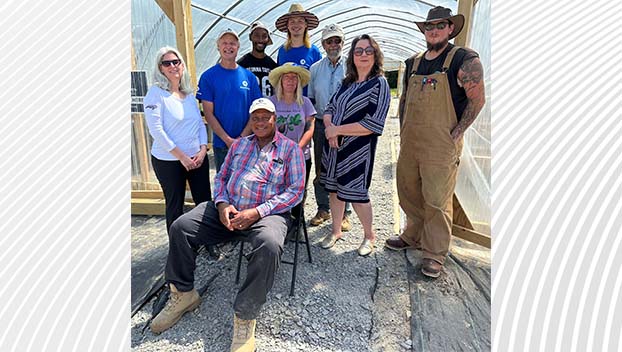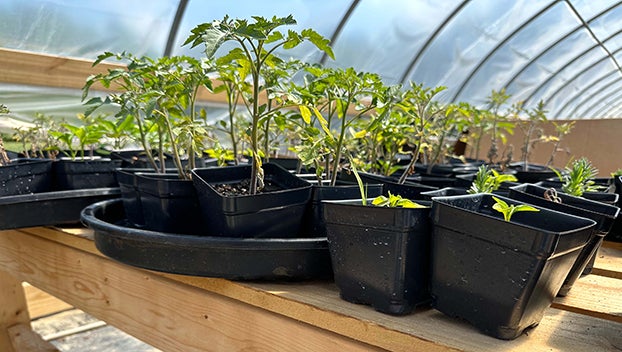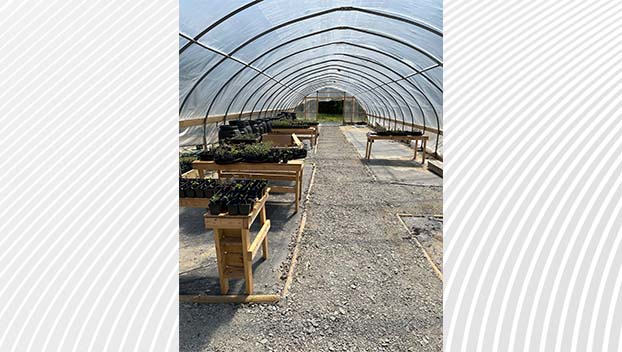New greenhouse addresses local food insecurity
Published 11:42 am Friday, April 28, 2023
|
Getting your Trinity Audio player ready...
|
The Blind Center and Pamlico Rose Institute (PRI) have teamed up to address food insecurity in Eastern North Carolina. On Wednesday, the groups celebrated the completion of a greenhouse which will produce fresh vegetables for families in need and give them information about healthy eating habits.
Construction of the greenhouse began in November, according to Sean Barker, a volunteer with PRI’s Health Corps.
The 100 ft by 22 ft greenhouse is located on land owned by The Blind Center in Washington. It is a hoop house style greenhouse. Its primary purpose is to supply fresh, natural food, but it will also have plants that will be used at PRI and a future garden at Beaufort County Community College.
To sustain the greenhouse, there are about 40 pickle barrels filled with 2,000 gallons of water that will act as a heat augmentation during cold months. Water will be captured off of a roof gutter system that during January through March when the sun shines through the greenhouse it will heat the barrels with water and produce ambient heat during the night which will keep the greenhouse about 15 degrees warmer than the temperature outside, Robert Sands, executive director of PRI explained.
Through a series of projects, the land will transform into a place that will “support people in a thriving life,” Tina Jandrow, executive director of the Blind Center said. The Blind Center offers vision care, prosthetic care, tech support and they offer cooking classes and art classes.
The land will have a nature trail where clients can safely and comfortably walk – even giving them freedom to choose if they want to walk alone or with another person. The trail will have “clues” made of recycled materials that will guide clients through the trail, Jandrow explained.
Also, the land will be used to host events like the center’s annual Kris Kringle event with a Christmas Village, their annual Music in the Dark, Dining in the Dark events and an audible Easter egg hunt.
The purpose for the expansion is “inclusivity,” Jandrow said. “Historically, a lot of our folks have been kind of dropped here and there’s not a lot involvement with the community. We’re trying really hard to stop that kind of unintentional segregation based on ability.”
In 2019, the Blind Center began conversations about addressing the health needs of their population. According to Jandrow, many clients were eating fast food because it is cheap, convenient and because some did not know how to cook for themselves. With the cost index of food rising by 82% in the area, it became a struggle for their population to purchase healthy food. This had a negative effect on clients’ health as they began to see more hypertension and Type 2 diabetes diagnoses.
“When we started talking about doing something where we could address their needs, two fold – one to be able to get fresh food to them, but two, to be able to have them own the preparation of that,” Jandrow said.
She continued to explain that growing fresh produce is a more cost-effective way than purchasing from somewhere. “As this begins producing, we have an entire curriculum…where our folks and their caregivers will be able to come in and do cooking classes and cooking lessons with products that we are pulling from our own property,”
“The beautiful thing is they are sitting in a room that is social, active, interactive and they’re leaning, prepping things, cutting things then they’re bringing it home and putting it in the freezer. Those families that were maybe eating beans out of the can on Wednesday night now they can reach into the fridge, pull out something and put it in the oven that is literally just a couple days past being pulled,” Jandrow said.
Speaking to PRI Health Corps volunteers who constructed the greenhouse, Jandrow said because of their hard work, the Blind Center can now have an efficient and broad impact on the community beyond what the center could do on its own.
Jandrow said the center estimates 300 households will benefit from the greenhouse in its first year and 1,500 households by its fifth year. Not all of it will be food, but some of it will be training and job readiness.
PRI Health Corps stems from the Pamlico Rose Institute which is a 501(c)3 nonprofit organization in Washington whose purpose is to help women veterans heal from trauma, anxiety, stress and addiction. This is to further help them transition from post-military service into civilian life.
PRI Health Corps is one of three health corps in North Carolina that was created through a partnership between AmeriCorps and the Centers for Disease Control. The PRI Corps will receive state and federal funding to maintain the project. AmeriCorps and Centers for Disease Control have a goal to meet public health needs of underserved populations. They work with local nonprofits to achieve this goal.
“This concept of synergy drives AmeriCorps programs throughout the country. Nonprofit organizations combine their resources with other nonprofits, state and local governments and other institutions to tackle the most challenging problems in the communities. Pamlico Rose Institute and The Blind Center are a perfect example of what this synergy looks like in practice,” Colleen Garrett said. Garrett is the monitoring and compliance officer in the North Carolina Commission on Volunteerism and Community Service, or VolunteerNC.
“VolunteerNC promotes volunteerism, is the lead agency in donations and volunteer management during disasters and administers 20 AmeriCorps programs across the state,” Garrett said.
“There are so many areas where the state, the federal government are not able to cover all the needs we have in our communities. When we have local organizations, local nonprofits, just individuals are able to step in and fill that need – it makes for more resilient and stronger communities all together,” Garrett said.








